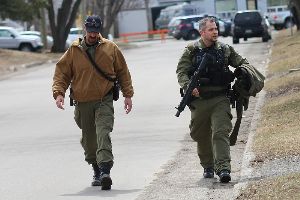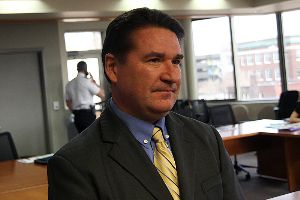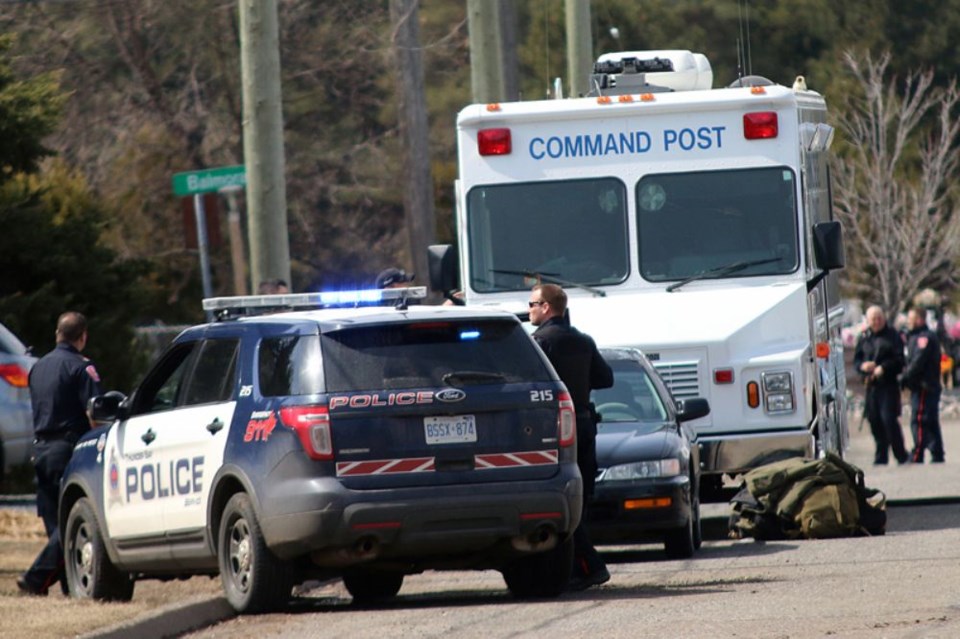THUNDER BAY -- The call can come at any time, whether it be the middle of a scorching summer afternoon or the heart of a dark, frigid, wintry night.
That’s the reality for members of the Thunder Bay Police Service’s emergency task unit. Those tactical officers always have to be prepared, never knowing when they will be needed or what they will face.
That has been evident in the first four months of this year; responding to three standoffs in just six weeks.
Most recently, they were involved in a five-hour incident after an armed 51-year-old man barricaded himself inside his Balmoral Street home.
Insp. Alan McKenzie, who acts as a senior incident commander, says the wheels begin turning as soon as the initial call is made.
The watch commander, who works as the shift supervisor, contacts a senior branch commander who authorizes the call for the tactical team. The tactical sergeant then calls out all members and gets the tactical team and containment teams into action.
In addition, a significant support staff that includes scribes, negotiators, media officer and radio communications officer is dispatched within the command post.
There can be as many as 50 officers involved in the call.
“It’s a choreographed exercise. Everybody has a job and everyone’s duties are contingent upon the other portion of the organization completing their task,” McKenzie says.
McKenzie describes the incident commander’s role as being the conductor of the operation, making strategic decisions and taking responsibility for the conduct of all officers on the scene.
The first roles for the incident commander are to formally take control of the situation and to create the mission statement, which is delivered to all officers.
“It can be something as simple as ‘we’re going to contain and negotiate to effect the arrest and peaceful surrender of the subject,’” McKenzie says.
“You always give that because you want everyone to understand what you’re asking of them.”

On the scene
In the early stages of the operation officers work to determine whether the subject is alone, has accomplices or hostages.
To do that, they reach out to those close to the subject, such as family, friends and loved ones, to learn more about the individual and the situation they’ve encountered.
They also try to gather as much visual evidence from inside the building as possible.
If the standoff started as a result of police involvement, criminal investigators question those first responding officers so no detail is forgotten or overlooked.
A critical goal is to contain the threat to protect the public. That often means evacuating adjacent buildings and restricting access to the area immediately surrounding the scene.
The tactical unit establishes an inner perimeter around the building in question with an outer containment area set up further out.
Traffic control is implemented in a wider circle to keep vehicles and curious bystanders away.
Dealing with those affected residents, who want to go about their daily lives with minimal interruption, can be one of the most challenging aspects of a situation.
While police don’t want to inconvenience anybody, sometimes there just isn’t a choice.
“It gets very difficult to not only get to them to get them out but once you get them out they want to return and do different things because you’re putting yourself and others at risk every time you move people in a line of sight of the residence,” McKenzie says.
“If we know what the threat is and we fail to take some sort of preventative measures, despite what you may want to do, for your own good it’s our duty to make you completely aware of all the potential risks and we do our best to encourage you. We try to offer you alternative places to stay, we’ll contact people and we’ll drive you there. We do everything we can.”
The negotiation
Isolating the threat allows the responding officers to focus solely on the subject. As the standoff proceeds, negotiators attempt to make contact with the individual and communicate while tactical officers, who have undergone rigorous training, remain vigilant and always prepared for the unexpected.
The negotiators can spend hours communicating, using active listening and showing empathy to the situation, to try to move towards a peaceful conclusion.
It often takes a substantial amount of time but it’s the surest way to reach the best outcome.
 “If there’s no activity, if there’s nobody under an immediate threat, then you just wait it out as long as you can. Going in and doing an entry is a last resort,” police chief J.P. Levesque says.
“If there’s no activity, if there’s nobody under an immediate threat, then you just wait it out as long as you can. Going in and doing an entry is a last resort,” police chief J.P. Levesque says.
Meanwhile, police have to continue business as normal throughout the rest of the city despite the major event.
That means many other officers are getting pulled in for overtime shifts.
“The calls don’t stop coming in for other police-related incidents just because we have a standoff going,” Levesque says. “It’s a challenge continuing to police the streets and be involved in one of these calls that are particularly resource intensive.”
Positive outcomes
So far, the outcomes have been positive.
The subject of a suspected Pruden Street standoff, who allegedly fired gunshots at a vehicle his ex-girlfriend was inside, was arrested without incident near the containment area on March 8.
A 55-year-old man who barricaded himself inside his Syndicate Avenue home for 19 hours surrendered without incident on March 23.
And this past Monday the Balmoral came to a peaceful end when the man surrendered.
But McKenzie knows there’s only so much police can control.
“There very well could come a day when a person has decided what their fate will be and nothing we say or do can change their mind,” McKenzie says slowly.
“But we will take every step we can and look for every opportunity and alternative to offer them so we can try to offer them some hope. Our job is to offer people hope and make sure the rest of the public is protected and safe.”
